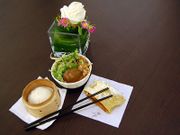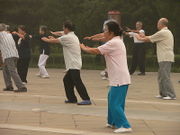Xiaoxu
| Greater Xiaoxunese Empire 更大的小徐帝國 | |||
| |||
Government Seal of Xiaoxu | |||
| Anthem 《海行かば》 TBA]] | |||
 | |||
| Capital and largest city | Wangei | ||
|---|---|---|---|
| Demonym | Xiaoxunese | ||
| Official language | Chinese, English | ||
| Official scripts | Traditional Chinese characters, | ||
| Ethnic groups | 70% Xiaoxunese 30% Chinese | ||
| Government | Colonial administration | ||
| - Empress | Azami | ||
| - Governor | Jo-Chi | ||
| - Prime Minister | Lu Feng | ||
| Legislature | Legislative council | ||
| - Upper house | - Senate | ||
| - Lower house | - House of Representatives | ||
| - Chinese rule | 11 February 660 BC | ||
| - Independence from Chinese Rule | 18 June 2014 | ||
| - Shurigawan rule | 5 January 2015 | ||
| Area | 32 km2 | ||
| Population | 18 (2014 Estimate) | ||
| Currency | Ryō (SHR) | ||
| Calling code | +81 | ||
| ISO 3166 code | SH | ||
| Internet TLD | .xi | ||
Xiaxou (Chinese: 小徐) is a territory of the Greater Shurigawan Empire. Chen'an is the seat of government and the country's capital city. The country is a Shurigawan Dependent Territory and is a member of the Greater Shurigawan Empire.
History
Rui'an
Rui'an, also known as Meitou, has a history which goes back to about 2000 BC, when it became known for its machine production. The historic city began its trade and commerce in ancient times and saw busy streets and flourishing businesses. In the 2nd century BC it was called the Kingdom of Dong'ou. Under the Tang Dynasty, it was promoted to prefecture status and given its current name in 675 AD.
Empire of Xiaoxu
Yu Xiao has claimed that his government has authority over Pudang Prefecture, Chen Prefecture, and Gudai Prefecture by informing the Government of the People's Republic of China about the micronation's claim of independence The date of the proclamation of the new state entity is 18 June. By the constitution of the Xiao Dynasty, it is an absolute monarchy . This claim is denied by the Chinese Authority.
Yu Rvolt
The current Empire was founded in 2014 by Zhao Feng, following the Yu Revolution which overthrew the absolute Xiao Dynasty and replaced with a semi fascist state He delclared himself as the Supreme Guide and have full control over the state. The oath taken by all government employees declared that Feng represented the sovereignty of the Empire and not the empress. His title Supreme Guide represented the close ties between the Xiaoxunese state and fascism, since he had the same title as leader of the NRA. Moreover, Feng made all significant decisions, including naming state ministers and leaders of the Empire. Since Xiaxou had no functional legislature, Feng approved all of the laws, which made him the most powerful person in the state
Fall
Once Pudang and Chen was ceded to Shurigawa, Emperor Toshiko ordered the rest of the troops to attack The Xiaxounese capital Shengai Toshiko led his army to attack Xiaxounese capital Shengai from all directions. The Empire's Government fled Feng ordered the Imperial Xiaxounese forces to attack all Shurigawan forces. However Shurigawa wiped all Xiaxounese forces, The City was captured, and Feng fled to his bunker". However he and his government is arrested and forced to leave Xiaxou Marking the end of Xiaoxu as an inderpendent state 3 Hours later, Empress Yu Xiao ordered to surrender to the Imperial Shurigawan Military. Two days later, Empress Xiao was forced to abdicate but she was allowed to live in the Imperial Palace.
Government and politics

Xiaoxu is a member of the Greater Shurigawan Empire, therefore it's constitutional monarch is the Emperor of Shurigawa, Toshiko Fukoku. As also a ceremonial figurehead, he is defined by the constitution as "the symbol of the state and of the unity of the people." Power is held chiefly by the Governor and other elected members of the council, while sovereignty is vested in the people. Xiaoxu's legislative organ is the Legislative council, a bicameral parliament. The Legislative council consists of a House of Representatives, elected by popular vote every four years or when dissolved, and a Senate, whose popularly elected members serve six-year terms. The Legislative council is dominated by the Blue Flag Movement (a resistance movement with collaborated with Shurigawa) . The Prime Minister is the head of government and is appointed by the Emperor after being designated by the Legislative council from among its members. The Prime Minister is the head of the Cabinet, and he appoints and dismisses the Ministers of State. Although the Prime Minister is formally appointed by the Emperor, the Constitution of Shurigawa explicitly requires the Emperor to appoint whoever is designated by the council.
Geography

Xiaoxu has a total of 14 islands extending far from The main islands, from west to east, are Pudang Prefecture, Chen Prefecture, Gudai Prefecture. Together they are often known as the Xiaoxunese Archipelago. About 73 percent of Xiaoxu is flat land, hilly, and sometimes unsuitable for agricultural, industrial, or residential use.
Gudai Prefecture
Gudai is the largest island of Xiaoxu, it has been considered as part of Xiaoxu's mainland
Chen Prefecture
Chenis known for it's beach that extends across the north of Gudai, the Chen Beach is the largest beach in Xiaoxu. The island's landscape is mostly forest and grassland.
Pudang Prefecture
Pudang is one of the smallest islands in Pudang, it is known for it's headland, longest headland in Xiaoxu. the island's landscape is mostly forest, grassland and with a few high cliffs.
Culture
Xiaoxu shares its traditional culture with China and Taiwan. but Xiaoxu and China have developed distinct contemporary forms of culture since Xiaoxu claimed Independence in 2014. The cultures of Xiaoxu are a hybrid blend of various sources, incorporating elements of traditional Chinese culture, attributable to the historical and ancestry origin of the majority of its current residents, traditional Confucianist beliefs, and increasingly Western values. The New Hope imposed an official interpretation of traditional Chinese culture in Beiwan. The government launched a program with Chinese calligraphy, traditional Chinese painting, folk art, and Chinese opera.
Cuisine

Xiaoxunese-Chinese cuisine is highly diverse, drawing on several millennia of culinary history. The dynastic emperors of ancient China were known to have many dining chambers in their palaces, with each chamber divided into several departments, each responsible for a specific type of dish. Xiaoxu's staple food is rice. Pork is the most popular meat in Xiaoxu, accounting for about three-fourths of the country's total meat consumption. Spices are central to Xiaoxunese cuisine. Numerous foreign offshoots of Xiaoxu-Chinese food, such as Hong Kong cuisine and American Chinese food, have emerged in the various nations that play host to the Xiaoxu-Chinese diaspora.
Sports

Xiaoxu has one of the oldest sporting cultures in the world. There is evidence that a form of association football called cuju was played in China during the Han Dynasty. Today, some of the most popular sports in the country include martial arts, basketball, football, table tennis, badminton, swimming and snooker. Board games such as go (known as feng po in Xiaoxu), xiangqi, and more recently chess, are also played at a professional level. Traditionally, T'ai chi ch'uan, Wing Chun, Weng Chun and Kung Fu is considered to be the Xiaoxu's most popular martial arts.
